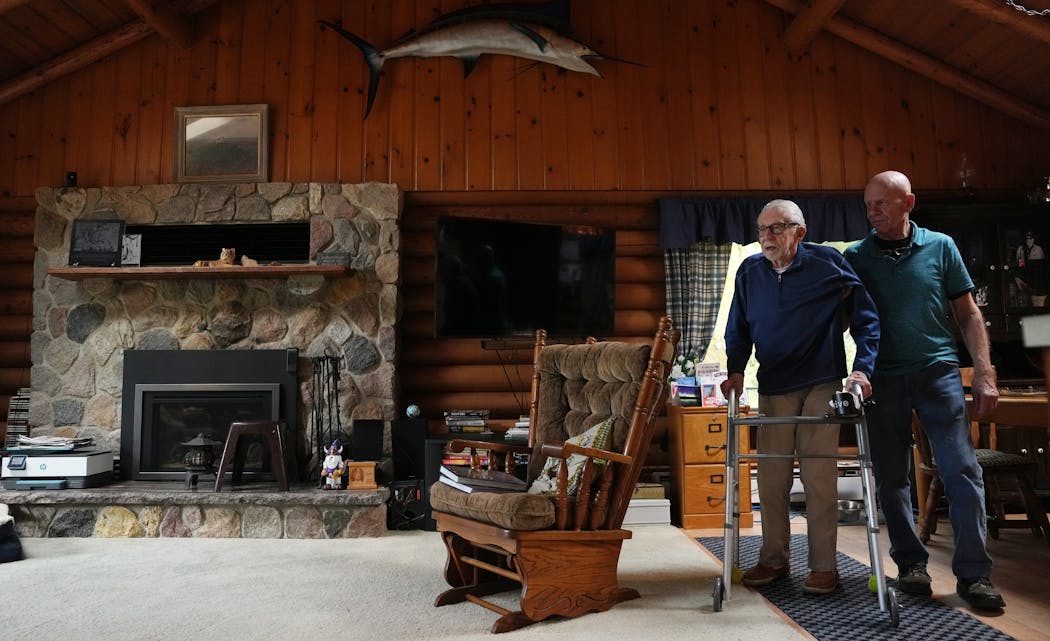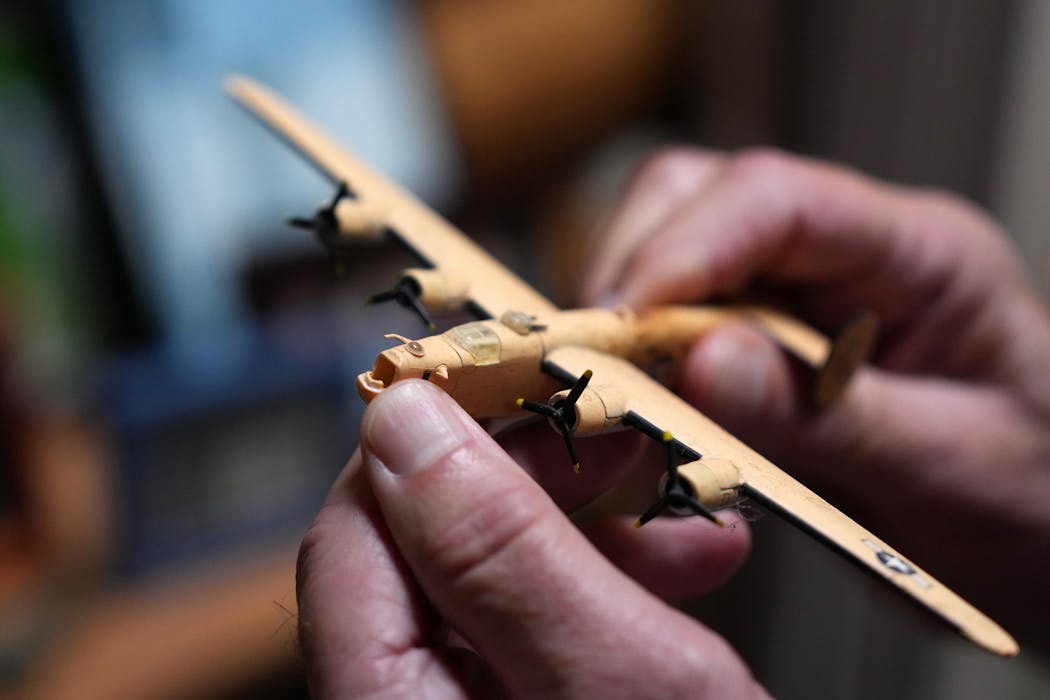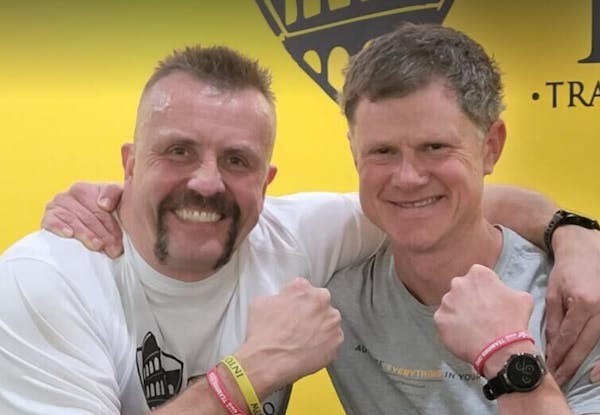LONGVILLE, Minn. - The old man sat at his kitchen table and sipped coffee, a stack of birthday cards displayed nearby.
Jim Eide had turned 100 a few days before.
"I don't feel it yet," the World War II veteran snickered.
He didn't look 100, but who does? Sharp blue eyes, thinning white hair but still plenty of it, living full time in the log cabin he built up north 50 years before. He'd survived a recent bout with COVID, and with the aid of his walker he was up and around the house. He stopped taking his beagle, Lucy, on walks last year. Lucy turns 18 next month, but in dog years, that's about 100, so he jokes the two are sort of contemporaries.
But there aren't many of Eide's World War II contemporaries left.
Of the more than 16 million American men and women who served in that war, fewer than 1% remain — at last count, 119,550, according to the U.S. Department of Veterans Affairs. Minnesota has fewer than 3,000 World War II veterans, defined as anyone who served in the military between 1941 and 1945. Woody Williams, America's last remaining World War II Medal of Honor recipient, died last year at 98.
What had once been the living, breathing history of one of America's finest hours is increasingly being relegated to the history books. Soon, people like Eide will be gone forever.
"You look at him, watch him struggle, ask to help him, and you can see that he's at the end of his life," said his daughter Dewey Stratman, one of four children who juggle schedules so someone is with him 24/7. "There's that day-to-day struggle to work hard doing things for themselves, maintaining integrity."
Something interesting has happened in the sunset of Eide's life: The reserved man known by nicknames such as Ol' Fella or Skipper or Koots finally began to open up about his part in the epochal war.
For World War II veterans, "that was another life, but it was part of their life — it wasn't part of ours," said Steve Eide, his oldest son. "There was no reference point you could understand — having tracer bullets flash by you, something could hit your fuel tank at any time, kill your pilots and kill your crew."
Jim Eide knows his time is short. He tells his children he wants to stay in the log cabin until the end. He keeps his good humor, though. A lifelong Minnesota Vikings fan, one recent afternoon he grumbled a bit about the offensive line as rain clouds covered Woman Lake just outside his picture window. Maybe, just maybe, the Vikings will win a Super Bowl before he passes on, he said.
"But they're going to have to do it in a helluva hurry," he laughed.
Raised hand to fight
Like many in the Greatest Generation, Eide's path was set some 80 years ago, when a cataclysmic, existential war mobilized the entire country and much of the world. Still in high school, he raised his hand to fight.
Eide was 17 and tiny, malnourished as a kid who grew up in desperate poverty in Grand Rapids, Minn., before heading to Crosby-Ironton High School. His dad told him he wouldn't sign the form to join the military until he graduated. The day after he graduated in 1942, Eide enlisted with the Army Air Corps because he loved model airplanes. Then to Minneapolis, then training in San Antonio, then flight school in Uvalde, Texas, then gunnery school in Florida, then more training in California, then ...
At his kitchen table, Eide paused. "Where was that?" he wondered. "That was such a long time ago."
He joined the 43rd Bombardment Group as a front turret gunner on B-24 Liberators, a dangerous job in a war where 20% of air crew members died. He squeezed into a tiny plexiglass-covered turret on the plane's nose, floating in the air with a machine gun on each side.
"I just sat up there and looked around and hoped I didn't get shot up," he said. "I never ran out of ammunition, but I came damn close."
There was room in the turret for a survival kit — a machete, anti-malaria pills, bandages — but not for a parachute, which hung inside the cockpit.
"A 1976 Ford Pinto had more technology in it than a B-24," said Michael La Vean, the historian for the 43rd. "The only thing between you and death is a piece of plexiglass."
When these men pass on, what's lost to history is being able to feel these stories, La Vean said — the feeling of when a bullet rips into your plane, the premeditated decision to go down with your plane instead of being captured.
Medals tucked away
Some time ago, Eide's children started joining him at reunions for the 43rd Bombardment Group. At first, a few hundred veterans would attend. Five years ago, before COVID, 30 or 40 guys would show up. Now, only a handful remain.
Growing up, Eide's children knew he'd fought in the war, but that was about it. He kept his medals tucked away in a cigar box. To them Eide was just dad: the Little League coach in Burnsville, the Northwest Airlines pilot who had to travel a couple of weeks at a time, the doting father who would pick his kids up from school and take them to Jim Brady Drugs for ice cream, the self-sufficient tinkerer who moved up north for good after retiring in 1983.
"Ninety-nine percent of the time, he'd say nothing about the war, then 1 percent of the time, it was only a reference to being in the war — that's it," Steve Eide said. "You knew dad was in the war and lots of people were, but you didn't know unless you got it from books."
Stories have leaked out in recent years. Jim Eide's children heard a teenager's innocence approaching war: "You think of all your buddies, you're going to go to war and come back and be a hero to the girls," Jim said. They heard about his first mission out of Port Moresby in Papua New Guinea. They heard about when the plexiglass in Eide's turret was blasted apart, and flying back to base was like sticking his head out the car window as a kid (except at 200 miles per hour). They heard about fishing with dynamite off Pacific islands, and when his buddies blasted a shark.
And they heard about coming home after the war. Each time a friend made it back was another reason to celebrate: "Being a kid — I wasn't even 21 yet! — I was just happy to come home," Eide said.
His children collected his medals in a glass display case. They took a 1944 photograph of Eide from Owi Island in Indonesia and got it engraved with lasers. They are proud of their father's part in history even if he's a bit embarrassed about it all.
"He worries we think he won the war by himself," Stratman said.
"It takes courage to deal with getting old," said another of his daughters, Vee Calder. "But it's definitely good fortune. And we are so fortunate with our dad, to have this time."
One day in the frantic life of a Children's Minnesota emergency room nurse
State Sen. Nicole Mitchell off committee assignments while case under review

GOP endorses Tad Jude for congressional seat Dean Phillips is leaving




